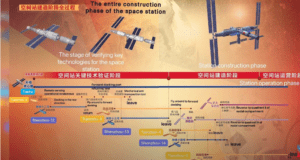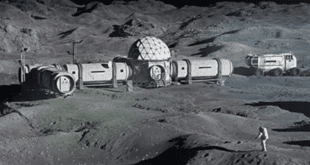by Blaine Curcio and Jean Deville
 As part of the partnership between SpaceWatch.Global and Orbital Gateway Consulting we have been granted permission to publish selected articles and texts. We are pleased to present “Dongfang Hour China Aerospace News Roundup 13 – 19 September 2021”.
As part of the partnership between SpaceWatch.Global and Orbital Gateway Consulting we have been granted permission to publish selected articles and texts. We are pleased to present “Dongfang Hour China Aerospace News Roundup 13 – 19 September 2021”.
Hello and welcome to another episode of the Dongfang Hour China Aero/Space News Roundup! A special shout-out to our friends at GoTaikonauts!, and at SpaceWatch.Global, both excellent sources of space industry news. In particular, we suggest checking out GoTaikonauts! long-form China reporting, as well as the Space Cafe series from SpaceWatch.Global. Without further ado, the news update from the week of 13 – 19 September2021.
1) Shenzhou 12 crew return to Earth, TZ-2 radial docking, (taking place on the 16 and 17) and upcoming TZ-3
Jean’s Take
After 3 months in orbit, the first crewed mission to the CSS, Shenzhou 12, composed of Nie Haisheng, Tang Hongbo and Liu Boming returned safely to Earth on September 17, marking a significant milestone in the construction of the CSS. Let’s go over the details, as quite a few things actually took place behind the scenes.
Let’s do this in a chronological order. On Wednesday September 15, the crew of 3 taikonauts left the living quarters of the Tianhe-1 core module of the CSS to enter the Shenzhou spacecraft which was docked to the front docking port of the Tianhe-1’s multi-docking node, and which the taikonauts had docked to 90 days prior on June 17. It’s worth noting that while the Shenzhou spacecraft is pressurized, the three taikonauts put on pressurized suits all the same for the trip to prepare for any unwarranted decompression, which could lead to unpleasant situations (RIP Soyuz 11).
Interestingly, rather than return to Earth, the Shenzhou 12 crew proceeded to test of one last maneuver, which consisted in performing a rendez-vous with the radial docking port:
- Separating from the front axial docking port
- Circumnavigating the space station, going from the initial position at the front of the Tianhe-1 space station module to a position facing the aft side of the Tianhe-1 (maintaining a distance of 2.5 km) and at the same time performing a 180° rotation in the yaw axis
- Then the Shenzhou spacecraft navigated to a position beneath the Tianhe-1 while performing a 90° rotation in pitch so the docking port of Shenzhou would be facing the radial docking port of Tianhe-1
- And then there were the final stages of the rendez-vous between Shenzhou and the Tianhe-1 radial docking port, with two stops at a distance of 200m and 19m, as well as a 180° rotation in the roll axis so the docking ports would be matched.
It’s also worth noting that this was just an verification test of radial rendez-vous so docking was not performed (also called an “R-Bar”, which has never been performed by China in the past as the Chinese had only performed axial docking (called V-bar). A CCTV report also mentioned that this more complex R-Bar maneuver could only be performed by Shenzhou due to its more sophisticated embedded computer, compared to the Tianzhou that only has axial docking capabilities. - The final step was to have Shenzhou return to the front of the Tianhe-1 multidocking node. This is to simulate an unsuccessful radial docking, in which case a Shenzhou spacecraft would attempt another docking with an axial docking port.
Now why did the Shenzhou 12 do this verification test at all? It’s because the Shenzhou-13 mission will have to dock in this manner (radially), because both axial ports will be occupied by Tianzhou spacecraft (2 and 3).
Moving on, after the circumnavigation operations were completed, the Shenzhou 12 carrying the three taikonauts then de-orbited to perform an atmospheric re-entry and land on Earth. This was done in 3 phases, starting at 12:43 pm China time on Friday 17/09: first step, Shenzhou separated itself from its orbital module, it then fired its engines to slow itself down and deorbit, it then separated from its propulsion module, leaving the capsule alone to enter the atmosphere.
After a fiery descent in the atmosphere (which absorbs most of the kinetic energy of the capsule, slowing it down from 7.8 km/s to 200 m/s or so), the main parachute is deployed to slow the capsule down further, and small retropropulsion engines are fired during the very last instants to enable a soft touchdown.
The landing site this time, and for the first time, was the Dongfeng landing site in the Gobi desert, and is situated 1000 km-ish west of the previous Siziwang landing site in Inner Mongolia. (This landing site was reported to be more adapted for operations with the Chinese space station. )
 So in conclusion, the Shenzhou-12 crew has returned to Earth, but China’s impressive space station construction phase does not stop there: in a couple of days, on Sept. 20, a Tianzhou 3 spacecraft will launch from Wenchang on-board a LM7 to dock with the Tianhe-1, followed by a Shenzhou 13 mission in October which will last a total of 6 months. And next year, we should witness the launch of the Wentian and Mengtian experimental modules, as well as the Tianzhou-4 and 5 cargo spacecraft and the Shenzhou 14 and 15 crewed missions; and after which the CSS will enter the operational phase. We’ll be covering those closely so definitely stay tuned to the Dongfang Hour!
So in conclusion, the Shenzhou-12 crew has returned to Earth, but China’s impressive space station construction phase does not stop there: in a couple of days, on Sept. 20, a Tianzhou 3 spacecraft will launch from Wenchang on-board a LM7 to dock with the Tianhe-1, followed by a Shenzhou 13 mission in October which will last a total of 6 months. And next year, we should witness the launch of the Wentian and Mengtian experimental modules, as well as the Tianzhou-4 and 5 cargo spacecraft and the Shenzhou 14 and 15 crewed missions; and after which the CSS will enter the operational phase. We’ll be covering those closely so definitely stay tuned to the Dongfang Hour!
Overall a lot of stuff happening in crewed spaceflight this week, but Blaine, there was also some stuff going on in launch, wasn’t there?
2) Launch update
Blaine’s Take
Lot of launch updates this week, and in fact not limited to China. Two parts to the launch update–first, updates on Chinese commercial launch companies over the past week, and second, discussion on global launch company activities in recent weeks, and how this may be reflected in the Chinese launch sector.
In China this week, the first update comes from Space Transportation, which successfully completed the third launch of their Tianxing-1 suborbital rocket. The Tianxing-1 is Space Transportation’s smallest suborbital rocket, and launched for the first time in April 2019, and again in December 2019. Little is known about the most recent launch, which took place on September 12, but very likely served as a high Mach number testbed for a given instrument payload. As we discussed in Dongfang Hour Episode 46, Space Transportation aims to have a price of RMB 5 million per flight for the Tianxing-1, or around US$800K, so if the flight was indeed for a dedicated customer, that gives us some order of magnitude of what they may have been paying.
To review, Space Transportation is a commercial launch company founded in August 2018, and raised a whopping 300M RMB in a Series A round of funding (see DFH Newsletter #15). The company is developing the Tianxing series of suborbital high velocity testbeds, and of which the Tianxing-1 and -2 have already flown. The company has also expressed interest in developing Earth-to-Earth space transportation and space tourism business, although the roadmap for such initiatives has not been revealed to date. The Tianxing launch was not, however, the only update this week from Space Transportation.
During the week, Space Transportation also completed a Series A+ funding round of “more than RMB 100 million”, with funding coming from SkyChee Capital and Silk Road Goldenbridge Capital Management. This comes just ~6 weeks after the company’s aforementioned Series-A funding round, and we can assume that Space Transportation has raised >¥400M over these past couple of months. Silk Road Goldenbridge is a returning investor from the Series A round last month, while SkyChee is a returning investor from an earlier 2019 round. Zhang Bin of SkyChee noted that there are relatively few areas in the space sector where China is leading the US in tech, and implied that one such area can be hypersonic spacecraft. Wang Tao from Silk Road highlighted the fact that Space Transportation has won orders from a variety of customers, and that their technology is relevant to both national defense and commercial flight. A pretty huge week for Space Transportation, but far from the only updates in the Chinese commercial launch sector.
In the Daxing District of Beijing, Interstellar Glory Space Technologies, aka iSpace and the Daxing District Government held a ceremony to commemorate iSpace joining the Daxing Commercial Aerospace Industrial Base. Once completed, the new iSpace facilities will cover an area of 60 acres, and will play an instrumental role in increasing the launch company’s manufacturing and testing capabilities. As we discussed in our Dongfang Hour Beijing Deep-Dive, there is a massive Chinese launch cluster around Daxing District, such to the extent that the area is known as “Rocket Street” (火箭街). With more than 10 launch companies having offices within a couple of km of one another, it may be the densest concentration of launch talent in the world.
The iSpace facility will include an assembly plant, tank welding plant, comprehensive simulation test center, and a host of other infrastructure related to the company’s Hyperbola-2 rocket, a reusable liquid methalox rocket that aims to have a first launch in early 2022. As we reported a few weeks ago, iSpace recently completed verification of certain parts of the landing legs for the reusable stage of the Hyperbola-2.
Finally, this week saw recently-founded commercial launch company oSpace announce the creation of a new subsidiary in Xi’an, one which will be dedicated to liquid propulsion. The subsidiary will focus on developing rocket engines, which is appropriate given the amount of launch industry talent and technological knowhow in Xi’an. Open roles at the new subsidiary include liquid rocket engine system designer, liquid rocket engine assembly designer, liquid rocket engine thrust chamber designer, and about 8 other roles, so to anyone looking for work building rockets in Xi’an, now is your chance.
Moving into the second part of our launch update, global commercial launch companies. Two things I want to unpack a little bit here, namely valuations and market development. On the valuation side, the valuation of some of these western launch companies is getting to be incredible. For example, since completing its merger with a SPAC around a month ago, Rocket Lab has seen its valuation increase by around 50%, to nearly US$7B (at one point a couple of weeks ago it was worth nearly US$10B). June of this year saw Relativity Space raise US$650M at a valuation of US$4.2B. German launch company Isar Aerospace has raised US$165M over the past year at undisclosed valuations.
While not necessarily an apples-to-apples comparison, when we look at the relative size, funds raised, and technological progress of China’s leading launch companies, several would likely be US$1B+ valuation companies. This is particularly true if looking at the relative premium that space companies tend to get in China. For example, Zhongtian Rocket is a recently-IPOed CASC subsidiary that makes rocket engines and related components. The company’s 2020 revenues were around RMB 863M (US$140M), and its current valuation is RMB 9B (US$1.45B). Italian launch company Avio, maker of the Vega rocket among other things, saw 2020 revenues of EUR 332M (US$390M), and valuation of EUR 285M (US$350M). That is, Zhongtian Rocket trades at 10x revenues, Avio trades at ~1x revenues. Landspace is a valuable company indeed.
Also related to the global launch business, this week, there was an excellent webinar on small launch vehicles in Europe (available on demand), organized by the Space Tech Expo Europe (thanks to Jacqueline for the recommendation!) Featuring Arianespace, Isar Aerospace, Rocket Factory Augsburg, and PLD Space, the webinar painted a positive future for European small launch vehicles, but also made clear that Europe is rather behind in launch compared to the US (and to some extent China), and that the launch business is uncertain, if not extremely high growth.
One interesting anecdote was Rocket Factory Augsburg commenting that for time-sensitive missions, the launch industry is a “seller’s market”, i.e. prices are strong and it’s good to be a seller if your customer wants to launch soon to a specific orbit. In this regard, China may be at an advantage, with ~20 domestic launch companies developing rockets today. One can imagine that even if 75% of these companies fail over the coming 3-5 years, it would mean that China would have ~5 launch companies capable of producing a couple tens of rockets per year each, i.e. 1 commercial launch every couple of days. While there are quite a few launch companies in Europe, the number of companies and amount of funding is considerably less than China. We have seen such flexibility already work as a competitive advantage in certain areas, including companies such as Spacety capitalizing on regular launch access to sell an in-orbit verification as a service.
Overall, a big week in launch, with quite a few China-specific updates, with a lot of excitement outside of China, and with some interesting questions about the future evolution of the launch business model. Jean, unless you have anything else to add on launch, maybe we can move into Martian UAVs?
3) Addition details on China’s Mars UAV, in an interview of Bian Chunjiang, the lead designer
Jean’s Take
Earlier this week, we got some additional juicy details on China’s Mars UAV prototype, which we mentioned also a couple weeks ago in a previous episode. As a reminder, a team from China’s NSSC’s Key Laboratory of Electronics and Information Technology for Space Systems successfully passed an acceptance test review for a project named the “Mars surface patroller & remote sensing key technology study” (火星地表巡飞光谱探测关键技术研究). Some first photos were revealed, where we could see a UAV with contra rotating rotors, with some resemblance to Ingenuity.
This week, through the interview of the lead designer of the project Bian Chunjiang in the China Science Daily, or 中国科学报, one of the oldest and largest science journals, managed directly by the CAS. We learn that:
- The current Mars UAV project started in March 2019, 3 years after China had officially announced it’s Tianwen-1 Mars project (which at the time was still just unofficially nicknamed “Huoxing-1” or “Yinghuo-2”). Bian Chunjiang applied for a Beijing Municipal Science & Technology grant for his research, which he obtained in December of the same year. It’s interesting to note that this project was to some extent bottom-up, a proposal from a scientist rather than a project that was already initially on the Mars roadmap.
- The idea behind the development of this Chinese Mars UAV prototype is to survey/acquire data on large surfaces of Mars: areas with several hundred of meters of radius in one flight (as opposed to a very slow speed of a rover, which achieves an average of a couple hundred meters only in one month). The Mars drone will also helpful in understanding the environment around the rover, and perhaps detect features of interest from high up and guide the rover to the given target.
And I think this is where you can see some contrast between China’s future Mars UAV, which carries some spectral imaging payloads, and NASA’s Ingenuity, which has some navigation cameras but is really more of a demonstrator mission with no scientific payload (but also, this is because the whole point of Ingenuity was to demonstrate the feasibility of flying on Mars, which in itself is huge). - We also have some characteristics: the rotors have a diameter of 1.4m, slightly longer than the 1.2m propellers on NASA’s Ingenuity. The total weight of the drone is 2.1 kg, which is also slightly heavier than Ingenuity, at 1.8 kg.
- Perhaps the most remarkable difference: the Chinese UAV charges its batteries by connecting itself to a rover on the ground, which acts like a power supply. This is a different solution to Ingenuity, which relies on solar panels to recharge its battery.
Overall some very cool drone stuff, but that is also very early stage. China’s next Mars mission is reported to be in the late 2020s (the late 2028 launch windows has been mentioned in some presentations), and Bian Chunjiang, the head of the mars UAV project himself says that there is still a very long way to go, possibly “5-6 years of research”, with the necessity to test the drone in simulated Mars environment, which is experimental infrastructure that China does not have at the moment.
This has been another episode of the Dongfang Hour China Space News Roundup. If you’ve made it this far, we thank you for your kind attention, and look forward to seeing you next time! Until then, don’t forget to follow us on YouTube, Twitter, or LinkedIn, or your local podcast source.
This has been another episode of the Dongfang Hour China Aero/Space News Roundup. If you’ve made it this far, we thank you for your kind attention, and look forward to seeing you next time! Until then, don’t forget to follow us on YouTube, Twitter, or LinkedIn, or your local podcast source.
Blaine Curcio has spent the past 10 years at the intersection of China and the space sector. Blaine has spent most of the past decade in China, including Hong Kong, Shenzhen, and Beijing, working as a consultant and analyst covering the space/satcom sector for companies including Euroconsult and Orbital Gateway Consulting. When not talking about China space, Blaine can be found reading about economics/finance, exploring cities, and taking photos.
Jean Deville is a graduate from ISAE, where he studied aerospace engineering and specialized in fluid dynamics. A long-time aerospace enthusiast and China watcher, Jean was previously based in Toulouse and Shenzhen, and is currently working in the aviation industry between Paris and Shanghai. He also writes on a regular basis in the China Aerospace Blog. Hobbies include hiking, astrophotography, plane spotting, as well as a soft spot for Hakka food and (some) Ningxia wines.
 SpaceWatch.Global An independent perspective on space
SpaceWatch.Global An independent perspective on space




